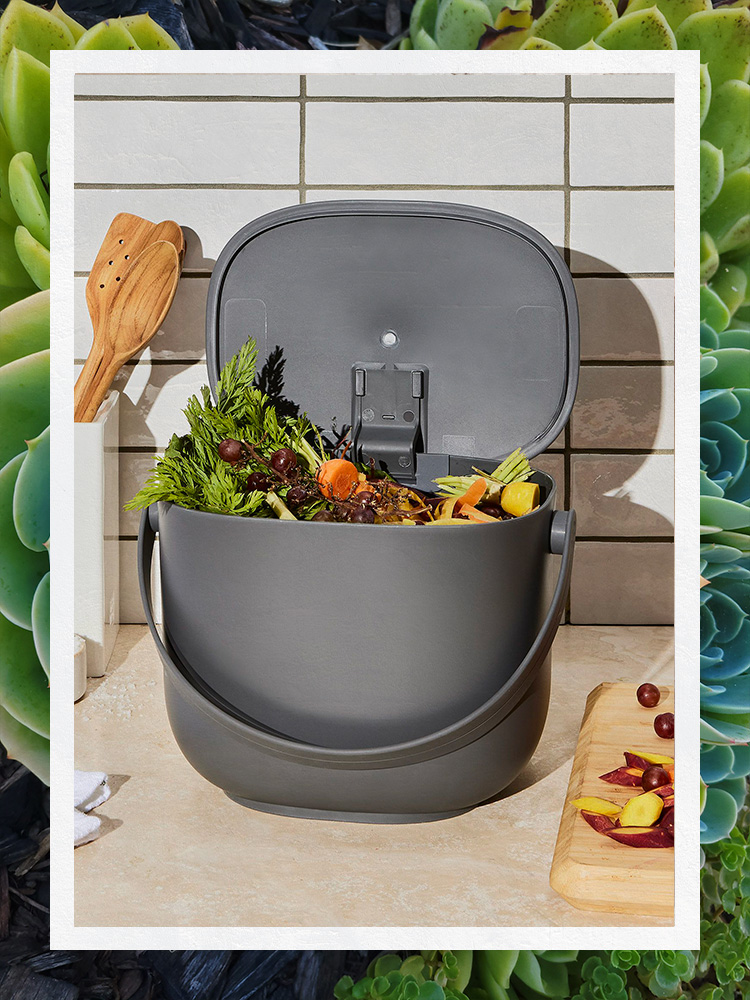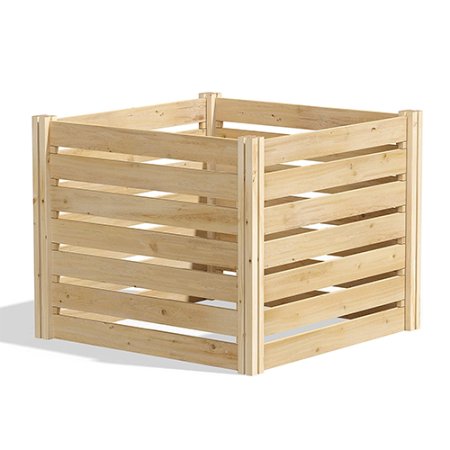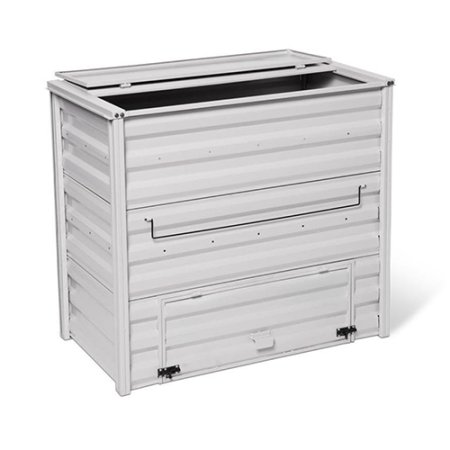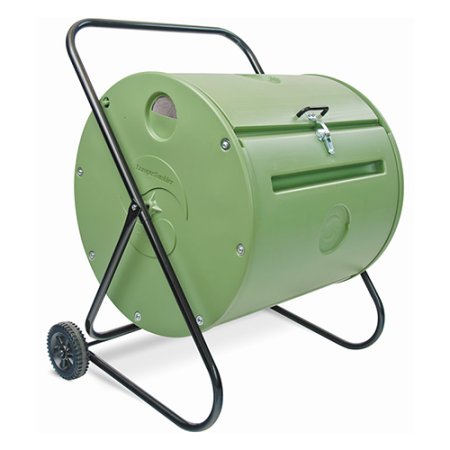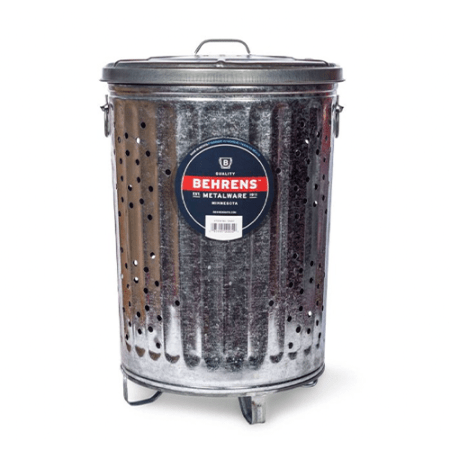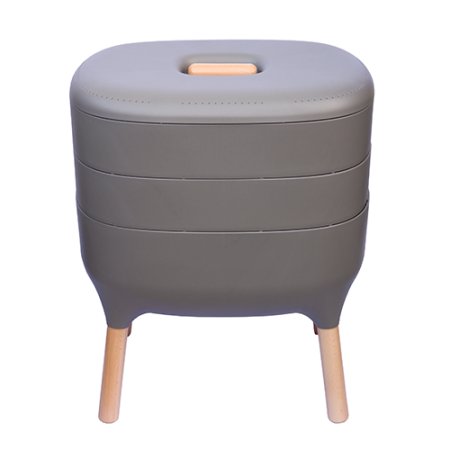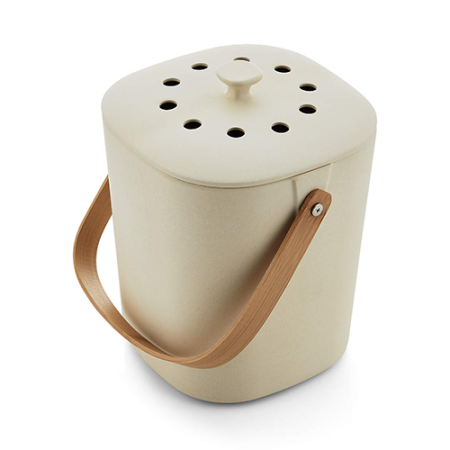We may earn revenue from the products available on this page and participate in affiliate programs.
Reading up on Domino’s shopping guides is like having your own personal product concierge. We do the tedious part—deep-dive research, hands-on testing, and tapping experts for advice—so all you have to do is hit “add to cart.” That’s why we call them Simply the Best.
It’s either that bunch of spinach left in the bottom drawer of your fridge or a banana that’s one day too far gone. Food waste happens, but it doesn’t have to be trashed—instead, grab one of the best compost bins. Just make sure to find one that meets your personal needs.
“What’s your end goal? Are you producing soil for a garden or just trying to reduce your landfill waste?” poses Kira Simpson, sustainability advocate and the creator behind The Green Hub. Whether you’re on the hunt for a container to simply transport cutting-board scraps to the farmers’ market or something a bit more robust to churn out fertilizer for your indoor jungle or outdoor greenhouse, our list of the best compost bins is for everyone—from the self-proclaimed professional to the soil novice.
Our Favorites
- Best basic: Greenes Fence Compost Bin
- Best critter-proof: Demeter Metal Compost Bin
- Best tumbler: Mantis Back Porch ComposTumbler
- Best compact outdoor: Behrens Galvanized Steel Composter Trash Can
- Best worm: Urbalive Worm Farm
- Best biodegradable countertop: Bamboozle Countertop Bin
- Best no-filter countertop: Food52 Five-Two Down-to-Earth Compost Bin
- Best for overnight soil: Pela Lomi Kitchen Composter
Best Basic: Greenes Fence Compost Bin
Best Basic
Shop NowType: Stationary | Size: 36- or 48-inch width and 31 inches tall | Indoor/Outdoor: Outdoor | Capacity: Varies
What we like:
- Large size, smaller price tag
- Made with North American wood
- Compost in 3 to 12 months, depending on scrap production
Worth noting:
- Untreated wood
Why we chose it: A no-frills, modular cedar container.
If you don’t mind an open container composter, you won’t have to spend more than $150 on a large customizable unit that’s a breeze to assemble (no power tools required). Slats of cedar come together through a dovetail construction, joined by spacer and corner posts that can be customized to expand based on your needs. Greenes Fence recommends a three-bin system: Start with fresh materials in the first, move it all to the second chamber when partially broken down, and add to the third section when the compost is ready. The low, 31-inch height makes it easy to lift a shovel over the side to mix up scraps, and everything stays aerated thanks to its slat construction and open top. But you might want to consider storing it far from the house, as it doesn’t trap odors.
Best Critter-Proof: Demeter Metal Compost Bin
Best Critter-Proof
Shop NowType: Stationary | Size: 36-by-20-by-32 inches | Indoor/Outdoor: Outdoor | Capacity: 82 gallons
What we like:
- Lockable door
- Compact square shape
- Stylish powder-coated steel
Worth noting:
- Doesn’t ship in recyclable packaging
Why we chose it: Latched and locked.
Sometimes an open-lid compost bin just doesn’t work if you happen to live in an area where racoons or rats linger (gross but true). In that case, you’ll need something that’ll prove tricky to break into, and this industrial-chic metal bin is a surprising fortress. Not only does it feature a hinged, latched lid that allows you to drop contents in from the top, it has a lockable door that keeps critters out until the soil is ready come harvest day. The only downside we foresee is that airflow might be hard to come by; manually churning your compost regularly is super-important with this model.
Best Tumbler: Mantis Back Porch ComposTumbler
Best Tumbler
Shop NowType: Tumbler | Size: 37-by-31-by-26 inches | Indoor/Outdoor: Outdoor | Capacity: 37 gallons
What we like:
- Wheels
- Secure door latches
- Powder-coated, double-wall frame
- BPA-free vented end caps, drainage hole, screened vents
Worth noting:
- Shipping and handling is extra
Why we chose it: A composter and hand truck in one.
While you can’t go wrong with any tumbler by Mantis, we’re particularly taken with the Back Porch ComposTumbler. Sure, it may be the smallest of them all, but its portability wins our favor. It stands alone, elevated above the ground (like any standard tumbler), and offers indented grooves for turning the trendy sage green steel drum. Equipped with two wheels, this composter makes distributing mulch, soil, and/or fertilizer all over your garden or backyard possible without breaking a sweat. Plus a removal door means all you have to do is dump and spread.
Best Compact Outdoor: Behrens Galvanized Steel Composter Trash Can
Best Compact Outdoor
Shop NowType: Stationary | Size: 18-by-18-by-26.5 inches | Indoor/Outdoor: Outdoor | Capacity: 20 gallons
What we like:
- Recycled steel
- Most affordable on the list
- 4 legs keep it off the ground
- Perforated for airflow
Worth noting:
- May dent easily
Why we chose it: Slender and simple, this classic pail is the reliable workhorse you’ve been looking for.
What looks like a standard trash can is actually a pretty efficient stationary composter, elevated by four small legs that keep it up off the ground. Lightweight and unassuming, you can situate this little number outside your back door or next to a shed (and a tightly fitting lid means you don’t have to worry about any critters getting into it). Not a single neighbor or visitor will know it’s actually transforming waste into garden gold—but perhaps our favorite aspect is that it’s the most affordable of our outdoor picks.
Best Worm: Urbalive Worm Farm
Best Worm
Shop NowType: Stationary | Size: 24-by-15-by-20 inches | Indoor/Outdoor: Indoor | Capacity: 15 gallons
What we like:
- Chic color choices
- Wood, mid-century modern–like legs
- Produces both usable soil and “worm tea,” a liquid fertilizer
Worth noting:
- White colorway often sells out
- A large learning curve (may be better left to the experienced)
Why we chose it: Vermicomposting, but make it stylish.
Matte gray, green, or white? You have your choice with this worm-friendly compost bin that could masquerade as a planter. The odor-free Urbalive Worm Farm is best suited for an indoor environment, which is great considering you can more easily control temperature and humidity levels compared to the outdoors so your worms stay happy (and full). Otherwise known as vermicomposting, tapping the appetite of worms is actually pretty popular in composting circles. “Worms are great for homes and apartments alike,” offers Kathryn Kellogg, the creator behind Going Zero Waste. But that doesn’t mean it’s the easiest route: You’ll need to avoid adding spicy foods, citrus, milk, and meat products. Coffee grounds and tea bags? They can’t get enough.
Best Biodegradable Countertop: Bamboozle Countertop Bin
Best Biodegradable Countertop
Shop NowType: Stationary | Size: 7-by-6.25-by 9 inches | Indoor/Outdoor: Indoor | Capacity: 1.15 gallons
What we like:
- Dishwasher- and freezer safe
- Variety of colorful exteriors
- Scandi design vibes
Worth noting:
- Filter needs to be replaced every 60 to 90 days
Why we chose it: An odor-blocking filter that actually works.
Who knew biodegradable bamboo could be so chic? Beyond its modern facade, this countertop-friendly compost bin is dishwasher safe and comes with a removable carbon filter that absorbs any sour smell your scraps may emit. Once it is full, and you’ve either dumped it off at a community compost site or toted it to a larger container in your backyard, you don’t have to worry about scrubbing or spraying down the interior; all you have to do is pop it in the dishwasher and it’s good to go.
Best No-Filter Countertop: Food52 Five-Two Down-to-Earth Compost Bin
Best No Filer Countertop
Shop NowType: Stationary | Size: 10-by-7.5-by-7.7 inches | Indoor/Outdoor: Indoor | Capacity: 1.5 gallons
What we like:
- 100 percent recyclable
- Dishwasher safe
- No filters, but just as odor blocking
- Cute, utilitarian appearance
Worth noting:
- Better for transporting
Why we chose it: Definitely cuter than schlepping frozen paper bags to and from the farmers’ market.
After discovering that 83 percent of its consumers were interested in composting, Food52 made its own bin that can hold days of food scraps without stinking up your entire kitchen. Take associate design editor Kate McGregor’s word for it. She brought this countertop bin home and, since adding it to her routine (a 20-minute stroll every Saturday to the local recycling center), can’t believe she ever lived without it. Its slick silicone silhouette is petite but perfect for small households and apartment living where the entirety of an outdoor space might be a fire escape, writes McGregor: “The best part of my new countertop companion: I can’t smell a single thing. I mean, I’m literally keeping rotting food and potting soil next to my coffee maker, so ensuring I don’t get a whiff of last week’s salad during my morning cuppa is crucial.”
Best for Overnight Soil: Pela Lomi Kitchen Composter
Best for Overnight Soil
Shop NowType: Tumbler | Size: 10-by-7.5-by-7.7 inches | Indoor/Outdoor: Indoor | Capacity: Less than a gallon
What we like:
- Fastest method
- Dishwasher-safe bucket
- Proprietary probiotic pads help speed things up
- Ships in recyclable packaging
Worth noting:
- Pricey
- Often in and out of stock
Why we chose it: Jump on the electronic composting bandwagon and get usable fertilizer in less than a day (seriously).
If you don’t have the patience to let Mother Nature do her thing, there’s always electric composting. This new method is what the Pela Lomi kitchen composter uses; you get ready-to-use soil by morning when you start the process at night, though its patented pods are an essential part of the equation. These little tablets are where the magic happens, filled with microbes that give you more soil and less waste. There are three cycles to choose from: Eco Express, Lomi Approved, and Grow. Eco Express only needs three to five hours to churn out what our reviewer noted as “immature compost,” which works best in a larger composter to finish processing. Lomi Approved, paired with a Lomi pad, runs a little longer, from five to eight hours, using low heat to keep microbes intact. Last but not least, the Grow mode creates the richest of the options (also with the help of a Lomi pad) and can be used with regular potting soil to give your plants a boost.
We Also Like
- Another simple wood bin option is the Gardener’s Supply Cedar Compost Bin. Made with rot-resistant cedar and designed in Vermont, it’ll blend into your backyard if you happen to have garden beds crafted from a similar material. Much like our basic pick, its sides are slatted panels that allow enough air through but mostly keep critters out (the hinged top door also helps). It does fetch a higher price, though, at nearly $350.
- If you happen to live in a location that’s heavily wooded or have enough trees that, come fall, your whole yard is covered, take advantage of the Gardeners Single Bin Wire Composter. Instead of raking all the fallen fodder and placing it at the curb, isolate it to decompose. Then all you have to do is wait, as air and water should naturally break the pile down into mulch.
- Maze is Simpson’s favorite brand. “They have everything from barrels to in-ground composts, bokashi, and worm farms,” she notes. This one in particular features two large chambers, a zinc-coated metal frame, and a UV-protected plastic body. It can be tricky to assemble, but once it is, you’ll have no issues turning your scraps into nutrients for your green friends.
How We Chose These Products
We tapped veteran features and garden editor Melissa Ozawa to scour the market for the best (and best-looking) compost bins, including picks personally tested by Domino editors and writers. Our selects speak to the size of your household and general living situation (single-family home with a backyard to studio apartment–friendly); offer a range of traditional to new methods (including an electronic option that transforms your scraps overnight); and come in a range of materials. While a black or dark plastic makes sense in terms of attracting heat and sun, it’s not exactly the most aesthetically pleasing. That’s why our choices stick to construction and designs that will more naturally blend in with your gardenscape, backyard, or balcony. And for the great indoors, we found a few countertop companions that won’t look out of place next to your fancy toaster (or battle the scent of espresso).
Our Shopping Checklist
Types of Composting
“There are essentially two types of composting: hot and cold,” explains Simpson. “Cold composting works by chucking all your scraps, your browns and greens, in the bin and letting the microbes (or worms) do their thing. Over time, the waste will eventually break down into a soft, crumbly soil.”
Hot composting, on the other hand, speeds the process up through aeration, typically by turning your compost bin one to two times a day. “This will allow for better oxygenation, which will feed the aerobic bacteria that assist in breaking the compost down faster,” adds Simpson.
Aside from these main traditional options, there’s also bokashi systems, which Simpson describes more as a fermentation process. “It essentially picks at your food waste so it breaks down quickly, and when the bin is full, you can bury it in the ground or a large pot plant,” she shares. It works using bokashi microbe powder (there’s also a spray version). Simpson says this is the general process: Just sprinkle the powder over your scraps, squash them down using a wooden spoon or the bin handle, seal with the lid, and repeat each time you have more food to add.
Tumbling vs. Stationary
The biggest difference between a tumbling and stationary compost bin is how you turn your scraps. A stationary bin means you’ll have to reach for a shovel or other device (Kellogg recommends a compost aerator) to move everything around. With a tumbler bin that’s usually lifted above the ground, you simply grab the handle and crank. It’s Kellogg’s preferred format; she argues it’s the easiest to use.
A stand-up, she says, is best if you have a bit of land, since it is usually pretty big in size. A tumble bin is not only great in an outdoor garden, but will do just fine if your apartment or rental home has a balcony or other small outdoor space. You’ll just want to stick to a more compact unit if the latter is the case.
Material and Design
Compost bins should be made out of durable yet low-maintenance materials—mainly metal and plastic, though wood works, too. If designed for outdoor placement, look for key words such as weather-resistant or UV protected. You’ll also likely want a bin that features a sealed or locked top to keep curious animals away. These will be larger in capacity compared to indoor-only composters, which are either a temporary hold for scraps to be transferred elsewhere or an electronic option that makes quick work of waste overnight.
Ask Domino
Q: How can I keep smells and flies at bay?
“If your compost is well aerated and balanced, there should be no pests or smell,” argues Simpson. “It’s also worth noting that some flies are good; it’s a natural process. These little flies, along with microbes, ants, worms, and bacteria, will help decompose the organics. But if the gnats become too much of a problem, add a thin layer of fine mulch over every layer of ‘wet’ waste you put in the bin. This layer makes it harder for the flies to get to the vegetable waste and will help reduce the problem.”
Or, points out Kellogg, you may just be missing some carbon-rich materials that will dually soak up moisture. You probably have some lying around your house, whether it’s paper towels, toilet paper, or even cotton products (yes, including dryer lint).
Q: What’s a good composting ratio I should keep in mind?
“Getting a good compost is all about balancing the carbon and nitrogen,” explains Kellogg. “You want at least a 50-to-50 percent mix; nitrogen is going to be fresh things like your grass clippings, tea bags, coffee grounds, and house fruit and vegetable scraps. Carbon is derived from brown materials, namely in the form of hay, wood chips, dried leaves, sawdust, and newspaper and/or cardboard.” For Simpson and Dominique Drakeford, co-founder of Sustainable Brooklyn, that ratio is more along the lines of 60 percent greens to 40 percent brown material.
“To me compost actually smells amazing and I’ve never had an issue with gnats. This is because I’ve I’ve added more browns (cardboards, hay, leaves, etc.) than greens (kitchen scraps). Folks get the nasty smells and bugs when they are over saturating their bin with wet kitchen scraps,” offers Drakeford. “I like to sprinkle a little cinnamon in my bin from time to time—I’m not sure if it really does anything substantial but it is an anti fungal and smells amazing!”
Q: If I want super-rich soil, what composter do I need?
For the best organic fertilizer, you can’t go wrong with a worm farm. It’s a bit of work (worms are pretty finicky—they’re not big fans of citrus, onions, dairy, or meat). If conditions are too hot or too cold, they can perish.
Q: Where is the best place to put a compost bin?
This really depends on your lifestyle. Some are designed to do just fine indoors, whereas others are meant to only be used outside. It doesn’t matter if you place it in a shady spot or an area where there’s a lot of direct sun; if you choose the latter, though, you’re likely to add more heat into the equation, which can help speed up the breakdown process.
Q: What’s the easiest composting method?
If you don’t want to deal with turning your scraps multiple times a day or having to trek your cuttings from the kitchen to the backyard on a regular basis, the easiest way to compost is to bring your scraps to a community compost or recycling program—we’d bet you can likely find one at your local farmers’ market. If you don’t mind it taking up space, store scraps in a compostable trash bag in the freezer until you can drop them off. While you personally won’t reap the benefits, it’s better than letting all of this organic matter be sent to an un-aerated landfill, and you’ll get to offset your individual carbon footprint, to boot.
But it’s worth putting in the extra work, if you can. For Drakeford, it’s more akin to a self-care routine. “Composting is one of my favorite garden rituals as it’s personally an ancestral practice where I can feed my spirit, garden, and minimize waste,” shares Drakeford. “I love it!”
The Last Word
The best compost bin is the one that works for you—that’ll depend on where you live, your family size, how you intend to use the compost in the end, and even how you eat. That’s why our list offers a range of options, no matter if you are providing fodder for your tomatoes and Swiss chard or just need a mode of transportation for monthly drop-offs.

